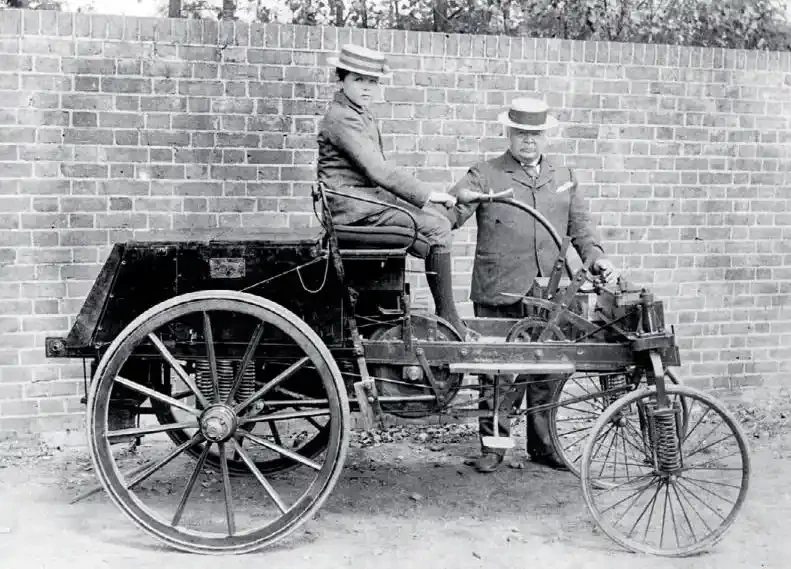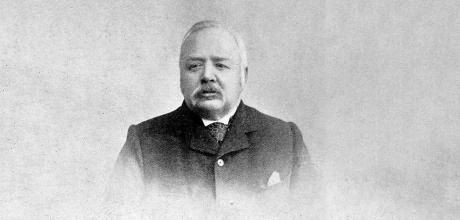Gone but not forgotten John Henry Knight 1847-1917
He built the UK’s first petrol-powered ‘car’ – and promptly racked up the UK’s first motoring offence
In automotive terms the Surrey town of Farnham, if thought of at all, is usually associated with Britain’s first Formula 1 World Champion, ‘Farnham Flyer’ Mike Hawthorn. Abbott coachworks may also strike a chord, with its elegant bodies on Lagondas and Bentleys as well as a series of Zephyr and Zodiac Farnham estate cars for Ford in the 1950s and ’60s. Less well-known is that the first petrol-fuelled British car was built in Farnham by John Henry Knight, and that it was he who committed the first motoring offence.

Born into a well-to-do Farnham family of local bankers, farm and brewery owners in 1847, Knight completed an apprenticeship with marine engineers Humphrey & Tenant in 1868 and built his first steam-powered horseless carriage the same year. Other steam vehicles followed, including a hop-digging machine that featured a trio of multi-pronged reciprocating forks at the front and wouldn’t have looked out of place in a Mad Max movie. Inventions of a less practical nature included a ‘dish lever’ for tilting a plate when carving, the commercial potential of which ranked among other Victorian curios such as the ‘top hat ventilator’ and ‘anti-garrotting cravat’.
More successful was the Trusty, a single-cylinder paraffin-fuelled stationary engine designed in 1884, of which 800 were built. Encouraged by the success of the Trusty and having toured French automobile factories, he converted it to run on benzoline, as petrol was then called, and fitted it into a three-wheeled ‘Motor-Cycle’ of his own design, the first of its kind in Britain. It became known as the Knighty and was constructed at his house, Barfield, on the edge of Farnham, commencing in February 1895, when there were no motor cars on British roads – the first, a Panhard et Levassor, was imported in the June. Engine building was entrusted to the constructor of the Trusty, Farnham’s Reliance Engineering, under the supervision of engineer George Parfitt in a West Street building that still exists – complete with commemorative plaque.
The motor was fitted horizontally into a rudimentary chassis with drive via two ropes running in pulleys of different diameters to give two speeds, with final drive by chain to one rear wheel. Steering was by tiller.
As an engineer, Knight recognised that the 1865 Red Flag Act, designed to protect horses and citizens from the fire-breathing, steambelching mobile furnaces of the day, was by then inappropriate, allowing Continental automobile manufacturers to gallop ahead, so to speak, of the British. So, on 17 October 1895, acting as an agent provocateur and chauffeured by his gardener and handyman James Pullinger, Knight chose to venture into the town centre without the mandatory man on foot 20 yards in advance! He was duly apprehended by a constable in Castle Street and came up before the beak at Farnham Petty Sessions, where he and Pullinger were each fined half-a-crown with 12s 6d costs.
Knight was now a marked man as far as the constabulary was concerned and, although he continued to use Knighty, he did so on private trackways but still often encountered lurking constables hoping to ‘nab’ him.
Finding that on rough surfaces the single front wheel was prone to wander, he converted his tricycle to four wheels by the simple expedient of duplicating the front end. As each wheel’s spindle was supported in a simple fork with twin coil springs, this happily created an independent front suspension.
In May 1896 the Knighty was the only British-built car at the first motor show. Held at Crystal Palace, it was billed in that peculiarly cumbersome Victorian manner as ‘The International Horse and Horseless Carriage and Roads Locomotion Exhibition’. The Red Flag Act was repealed the following November. Knight had barely completed Knighty when he published the first of his motoring books in 1896: Notes on Motor Carriages (With Hints for Purchasers and Users), the cover featuring a photo of the three-wheeler, Knight and wife aboard. Other books followed, including in 1902 A Catechism of the Motor Car, which, as the title and a note on the title page indicates, is a series of ‘About 400 Questions and Answers Explaining The Construction and Working Of A Modern Motor Car’ with, in the 1914 edition, an ‘Additional Chapter On The American Cars’. Henry Ford had arrived.
In 1905 Knight was a founder member of the Motorists’ Mutual Association, soon to be renamed the Automobile Association. At that point the purpose of the club was not to help in the event of breakdown but to warn motorists of speedtraps through strategically posted spotters! Its first members’ run was from London to Barfield, which became a school in the ’30s. Mike Hawthorn was a pupil.
Knight died at the age of 70 in 1917, still inventing. Knighty was presented to the Science Museum by his family in 1958 on the proviso that it be displayed in the Montagu Motor Museum, where it remains.
Left John Henry Knight with his son and his benzoline-powered four-wheeler ‘Knighty’, converted from its original three-wheeled configuration.


